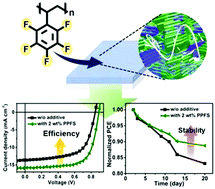Ring-perfluorinated non-volatile additives with a high dielectric constant lead to highly efficient and stable organic solar cells†
Abstract
With the increasing concern for discovering a new processing additive, the effects of polymer additives (polystyrene, poly(styrene-b-pentafluorostyrene) and poly(pentafluorostyrene)) on the PBDB-TT5:ITIC blend system were thoroughly investigated to obtain a direct comparison with the widely used volatile solvent 1,8-diiodooctane additive. Although different additive types (solid vs. solvent) act via different mechanisms within the active layer, the use of each optimal amount enables improved power conversion efficiencies (PCEs) to various extents. Among them, viscous PPFS was found to be the most effective, resulting in a remarkable improvement in the PCE from 7.90% to 9.29%. Interestingly, the PPFS has a high dielectric constant that can not only induce the enhanced dielectric property of the active layer but also serves as a morphological locking-in agent, conferring long-term and thermal device stabilities. Moreover, we successfully improved the PCEs for other host systems (J71:ITIC, PTB7-Th:PC71BM, and PTB7-Th:PNDI-T10) through PPFS addition. For J71:ITIC, the PCE reached a maximum of up to 10.7%. Our study highlights that the use of PPFS is a simple and practical technique to improve the PCE and stability of devices, with the expectation that further molecular design involving high dielectric constant polymer additives will likely obtain more interesting results in various optoelectronics.



 Please wait while we load your content...
Please wait while we load your content...